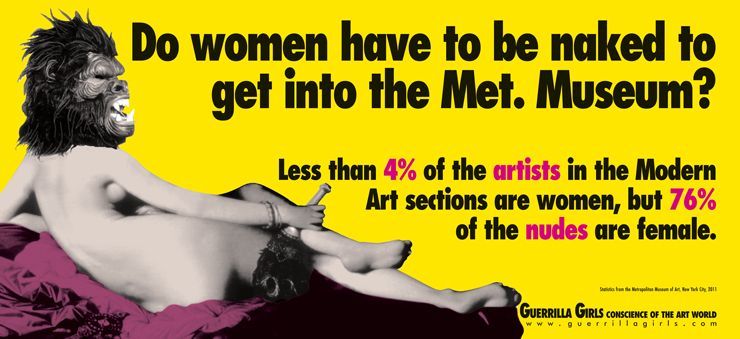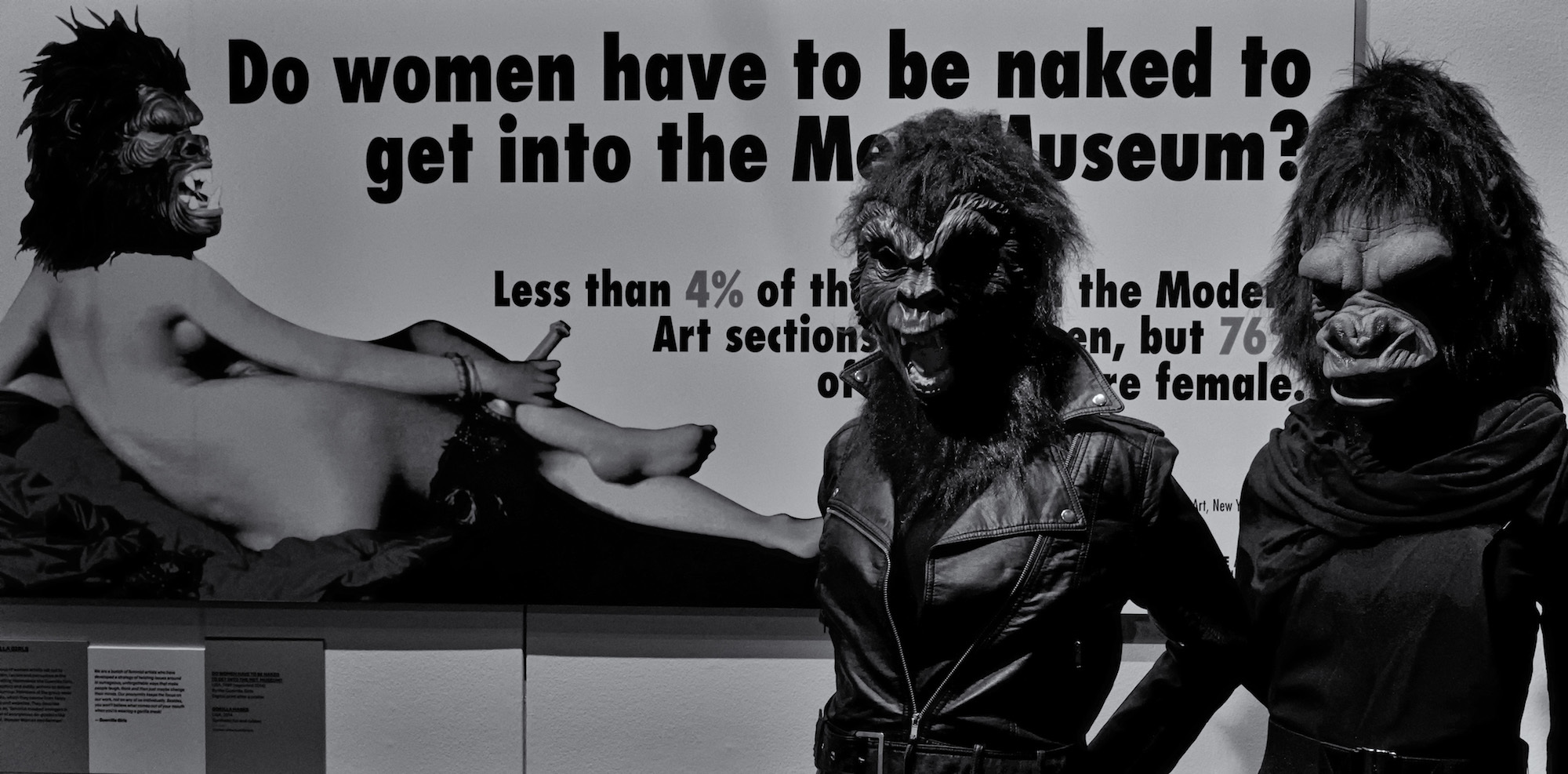Forget what you know about all-girl art gangs. You know, the ones that take pictures of glittery tampons and wax lyrical about their dip-dyed armpit hair. For now, just concentrate on the Guerrilla Girls, the original collective of masked rebels who have been campaigning tirelessly against gender and racial inequality in the art world since 1985. So renegade was the group’s movement that to this day we still have no idea about its members’ true identities. Concealed by their gorilla masks, they go by the names of Kathe Kollwitz, Alma Thomas, Rosalba Carriera, Frida Kahlo, Julia de Burgos, and Hannah Höch.
Formed in reaction to the Museum of Modern Art’s seminal exhibition An International Survey of Recent Painting and Sculpture, in which only 13 of the artists featured were women (the remaining 153 were men), it wasn’t long before the Guerrilla Girls were invading art galleries and staging protests outside of national museums in the group’s native New York City. Avengers of the marginalized — women, artists of color, members of the LGBTQ community — the Guerrilla Girls’ most iconic work was a poster depicting a nude woman in a gorilla mask, with the now immortalized line: “Do women have to be naked to get into the Met? Less than 5% of the artists in the Modern Art sections are women, but 85% of the nudes are female.”
Over 30 years later and the Guerrilla Girls are still as politically charged, socially aware, and, above all, as fearless in the face of inequality as they were in 1985. This year alone, the collective worked on four new projects, all of which critique museums right on their own walls. First, a video articulating the lack of diversity at the Minneapolis Institute of Art. Next, a huge street banner in Cologne about billionaire art collectors exerting more and more control over museums, as well as the video Girlsplaining Museum Ludwig. After that the group headed to London, for an exhibition at the Whitechapel Gallery examining diversity within European and UK museums, based on the results of a questionnaire sent to 100 museums. Then, at Tate Modern, the collective launched the Guerrilla Girls’ Complaints Department, whereby visitors could come and complain about any issues they felt burdened by, they could even criticize the museum.
Showing no signs of slowing down, we caught up with head guerrilla Kathe Kollwitz to find out what kind of revolutionary disruption will come next.

What do the Guerrilla Girls stand for?
To fight discrimination in culture and politics. We have a unique game-changing way of doing political art. We’ve done over one hundred posters, books, stickers, giant billboards, and banners. We twist issues around, using facts, humor, and outrageous visuals with the goal of changing people’s minds about issues. We like to think of ourselves as creative complainers.
Why is it so important to have a female-friendly space within art?
Women’s issues tend to be minimized and feminism demonized. We reveal the understory, the subtext, the overlooked, and the downright unfair.
Do female artists produce work that is inherently different to men? Should they?
If art is informed by life experience, why wouldn’t the art of women and artists of color be different from art made by white men? It’s so obvious that their life experiences are very different.
How can you affect social change through art?
We say: don’t be paralyzed because you can’t do everything. Just do one thing. If it works, do another. If it doesn’t, do another. Also, make sure your activist work communicates by test-driving it first. Show it to a few people and see if they get it.
Is there a danger of ghettoizing female artists, and therefore reinforcing inequality between the sexes?
Who cares about ghettos? You can’t tell the story of our culture without including the work of women and artists of color. Without them art history is a white male ghetto.

Why do you think now is the time for all-girl art collectives?
It’s always time to join forces and stand up together for the “f” word — feminism — no matter what gender you are. We think it’s crazy that so many people are still afraid to call themselves feminists. Feminism doesn’t get the respect it deserves, but it is changing the world, revolutionizing human thought, and giving many people lives that previous generations could never have imagined. Resistance movements are exploding all over the world. There is still so much more work to do!
Looking back at your entire career, what’s been your greatest achievement?
With artists, there is no greatest achievement. It’s the cumulative effect of doing one thing after another and always trying to do it more effectively. We try to craft political art that is unforgettable. A perfect example of that is our poster, Do Women Have to be Naked to Get Into the Met. Museum? After seeing that poster, if you really read it and it gets inside your brain, you will never look at museums the same way again. We are also proud that we have inspired so many people all over the world to do their own crazy, creative activism. You wouldn’t believe the thousands of emails we get from people 8 to 80.
Feminism has become part of the cultural conversation in a way it hasn’t before. Why do you think it is?
The Guerrilla Girls have always believed in an intersectional feminism that fights for the rights of everyone. We think everyone, no matter what their gender or background, should stand up for feminism. It’s time to stop demonizing feminism and recognize it as one of the great human rights movements of our time, along with civil rights; lesbian, gay, bisexual, transgender and queer rights; Black Lives Matter; and so many others.
Moving forward, what positive changes for women would you like to see in the creative industries?
All our research shows that the world of culture is not avant-garde, as it pretends to be, but derrière. There’s a long way to go.
What’s next?
More street actions. More posters, banners, and exhibitions criticizing the corrupt billionaire-controlled art system. And — as always — more creative complaining.
Credits
Text Tish Weinstock
Image via Wikipedia
